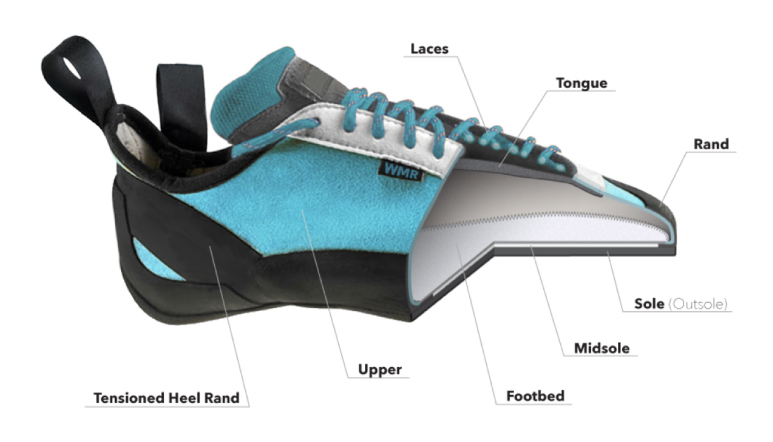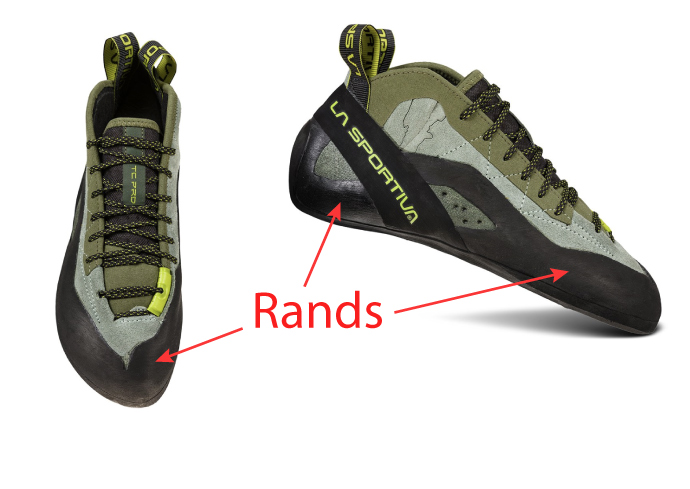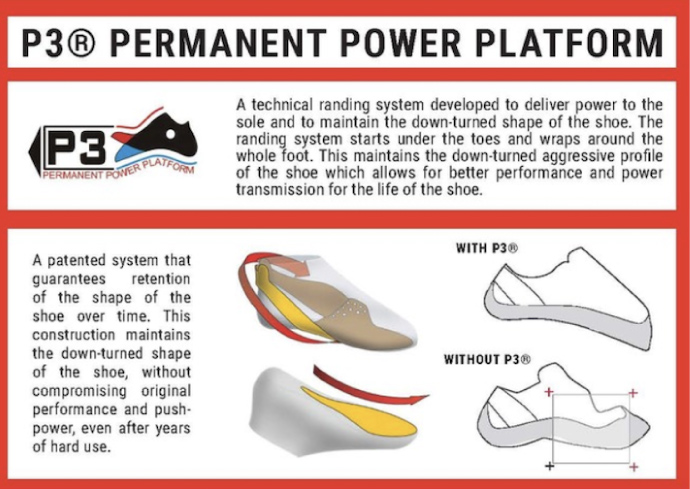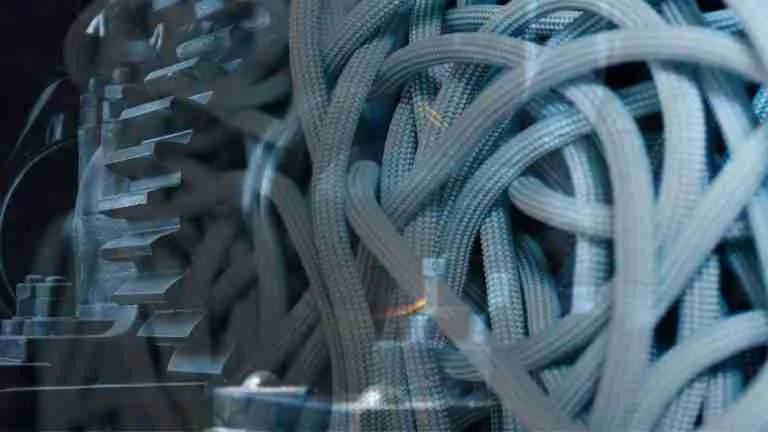If you’re wondering how to choose a climbing shoe, you are not alone.
With so many different types and styles out there, which is the best climbing shoe for you?
To choose the best climbing shoe there are a few important considerations.
Mainly, you need to know about neutral, moderate, and aggressive climbing shoes; shoe last, stiffness and asymmetry; as well as closure types, rubber, and fit.
Below we breakdown each of these considerations to help you choose the best climbing shoe for your needs.
What Type of Climbing Shoe Do You Need
Here’s what you need to consider when choosing a climbing shoe:
• Types of Climbing Shoes
• What Type of Climbing You Do
• Climbing Shoe Features & Anatomy
• Climbing Shoe Fit
Climbing Shoe Types
When choosing a climbing shoe, there are three main types of climbing shoes to choose from:
• Neutral Climbing Shoes
• Moderate Climbing Shoes
• Aggressive Climbing Shoes
This roughly translates to multi-pitch and trad climbing shoes for neutral to moderate, and sport climbing and bouldering shoes for moderate to aggressive.
Sport climbers will want a more aggressive, snugger fitting shoe that is easy to take on and off. Stiffness depends on preference but most sport climbers wear a medium stiff to soft shoe (if you are a beginner, get a stiffer shoe while your feet build up strength).

Trad and multi pitch climbers, however, will be better off with a more neutral or moderate shoe that can be worn all day. In addition, look for a stiffer board-lasted shoe (more on this below) for trad or multi-pitch climbing. A stiffer last provides added support and reduces foot fatigue on long routes.
In climbing shoe terms, “aggressive” means a more asymmetric and downturned last with a more flexible midsole.

The more aggressive a shoe is the better it will be at steeper more technical climbing.
An aggressive last will angle down and the amount of asymmetry determines how much the toe angles inward in relation to the rest of your foot. This forces your weight and power onto your big toe, giving these shoes better edging on steep and technical climbs.
A more downturned shoe also helps transfer power downwards so that you can maintain edge contact on overhanging routes where it is hard to get your weight on your feet.
For example, the TC Pro is a moderate to neutral climbing shoe, while the evolv Phantom is a classically aggressive climbing shoe.
Neutral Climbing Shoes
For an all around shoe that can be worn all day on any route at any level, neutral to moderate climbing shoes are a great option.
These shoes occupy the middle of the climbing shoe range – between aggressive and snug versus flat and comfortable.
While neutral shoes tend to be beginner friendly, that doesn’t mean they aren’t capable of tackling hard routes as well.
Arguably one of the oldest and greatest all around shoes ever created, the La Sportiva Mythos, is a medium-neutral climbing shoe that many climbers still use for everything from long crack climbing to overhanging crimps and tufas.
Mythos’ are built with La Sportiva’s RN 25 last – RN stands for for Round Neutral.
As a testament to the Mythos, here is Alexander Huber free soloing the 550 meter Hasse Brandler Direttissima VIII+/12a in his Mythos climbing shoes.
And in case that isn’t proof enough, the guy is still climbing 5.14+ in these shoes!
Also to note, Alex Honnold free-soloed Freerider on El Cap in the the moderate-neutral TC Pro. Just saying.
Moderate Climbing Shoes
Moderate climbing shoes will have a slightly more asymmetric footbed, softly downturned last, and often a stiffer midsole.
A great example of a moderate climbing shoe is the TC Pro, the Scarpa Vapor or La Sportiva Katana.
Moderate climbing shoes are great all-around shoes for climbers looking for one shoe that does it all.
From sport climbing to multi-pitch to long trad mountaineering routes, moderate climbing shoes with a bit of stiffer midsole will keep your feet from burning out after long hours on the wall.
Aggressive Climbing Shoes
If you are doing some steep caving, overhung-technical boulder routes, or techy face climbs; more aggressive climbing shoes will get you there.
A more aggressive shoe like the Scarpa Instinct VS will have an exaggerated inward angle and downturned toe, a snug almost compression like fit, and may or may not have a stiff midsole (most often this type of shoe will have a slip-lasted midsole).
For an example of a slip-lasted shoe, check out one of the most famous and adored slipper climbing shoes of all time, the 5.10 Moccasym (previously the Anasazi).
Keep in mind, aggressive downturned shoes are meant to fit tighter and often lack a stiff midsole for support. These shoes usually are not comfortable for long periods of time.
So, if you are doing a multi-pitch with one super techy crux, it might be worth it to carry a more comfortable moderate pair of climbing shoes for the rest of the route.
What Type of Climbing Do You Do?
When choosing the best climbing shoe you have two options; get one all around shoe or get a few specialized shoes for each type of climbing.
This decision is dependent on what type of climbing you do most often.
Climbers who only boulder for example, can get one pair of shoes like the evolv Phantom and never need another shoe.
However, if you mostly sport climb and occasionally boulder, you are better off with a more supportive but technical shoe like the La Sportiva Miura that can do both.
For climbers who do a little bit of everything from trad to boulders to the gym, its best to spend the most money on the shoe that is best for the type of climbing you do the most often.
In most cases this shoe will still perform well in other types of climbing.
People who spend most of their time on sport routes and occasionally go to the gym or bouldering will be happy with an all around shoe like the Miura.
However, if you mostly trad and multi-pitch climb with occasional outings to the gym or local boulders, a shoe like the TC Pro or Miura are smart choices.
Or, you can get one pair of shoes for each type of climbing you do. This is the best but most expensive approach.
Climbing Shoe Features: Anatomy of a Climbing Shoe
Climbing shoes have a few main parts that contribute to their overall fit and performance:
• Lacing or Closure System
• Build Materials
• Last and Asymmetry
• Midsole
• Outsole and Rubber
• Rands
To help you choose a climbing shoe that’s right for you, let’s take a look at each of these climbing shoe components in detail.
Climbing Shoe Lacing or Closure System
When it comes to how a climbing shoe stays on your foot, there are three main categories: lace-ups, velcro, and slippers or slip-on climbing shoes.
How to choose a climbing shoe with the right closure system for you depends mostly on what type of climbing you do most often.
Laces give the most secure and customizable fit. However, if you like to wear your shoes super snug to the point you have to take them off between climbs, laces can be time consuming and cumbersome.
Velcro shoes give you almost all the adjustability of laces with a much quicker on-off compared to lace-ups.
Keep in mind some velcro climbing shoes offer a more variable fit than others.
The La Sportiva Miura VS for example, has three large velcro strips while many other velcro shoes only use one or two thin velcro strips without webbing straps sewn in to equalize tension.
Slippers or slip-on climbing shoes offer the easiest and quickest way to get your climbing shoes on and off.
No laces or velcro means these shoes are low profile, truly meant to fit like a ballerina slipper.
Slip-ons usually have a snugger heal with rands or material that wraps your heal to help lock the foot into place.
When choosing a climbing shoe with a slipper design, remember they will need to fit a bit more snug than other shoes to make up for the lack of adjustment without laces or velcro.
Slip-on climbing shoes offer the least support and most narrow profile of any climbing shoe type. This means you will carry more tension in your feet but the narrow profile also makes them edging machines and great thin crack climbing shoes.
Climbing Shoe Build Materials
One big consideration when looking at how to choose a climbing shoe that is right for your needs is what material the shoe is made of.
Climbing shoes are either made of leather or synthetic materials.
Leather can be lined or unlined. Lining is usually a synthetic breathable fabric. Some shoes are only lined in the toe or forefoot while others are completely lined.
Lining helps reduce leather stretch but can be slightly more odorous over time.
Keep in mind, unlined leather can stretch 1/2 to a full size once broken in – size your shoes accordingly.
Synthetic materials come in a range of compositions. If you prefer vegan climbing shoes (check out evolv shoes for the most vegan options) or more environmentally conscious shoes, synthetics are often the better choice.
Stretch is less of an issue with synthetic materials. They do give a little bit after breaking in, but in general 1/2 size at most.
Climbing Shoe Last and Asymmetry
Lasts are used in the manufacturer of all types of shoes.
A shoe last is a solid form that a shoe is built around. This form gives each model of shoe its unique shape and volume.
For climbing shoes, there are two types of last you will encounter: slip-lasted and board-lasted.
Here’s a video from climbing shoe manufacturer Scarpa explaining the difference between slip-lasted and board-lasted shoe construction:
Slip-lasted climbing shoes yield a softer more flexible shoe. They use a fabric bottom piece, sew the upper fabrics onto that sole fabric, then “slip” that over the last to finish the shoe build.
Board-lasted climbing shoes are stiffer, offering more support than slip-lasted shoes (most non-climbing shoes are board-lasted).
These shoes start with a stiff bottom piece that is secured to the last, the uppers are then glue to and built around that stiff bottom board.
Asymmetry is determined by the shape of the last and refers to the angle at which the toe arches inward and/or downward.

The greater the asymmetry the more weight is focused on your big toe, providing greater edging and precision.
While highly asymmetric shoes are great for technical climbing, keep in mind that they are meant to fit more snug in the footbed and are not comfortable to wear for long periods of time.
Climbing Shoe Midsole
The midsole helps determine the stiffness of a climbing shoe. Midsoles are the “board” referred to above in board-lasted climbing shoes.
Less midsole means a shoe will have more “feel” compared to a fully board lasted shoe. For this reason, higher performance aggressive climbing shoes are slip-lasted and without a midsole or with a limited midsole.
For board-lasted shoes the midsole runs the full length of the shoe.
Slip-lasted shoes may only have a midsole in certain areas or no midsole at all depending on design and intended use.

For reference, in running shoes or approach shoes, the midsole is a layer running the entire length of the shoe in-between your insole and the rubber outer sole of your shoe.
Outsole and Rubber
As the name implies, a climbing shoes outsole is the outer rubber sole that actually makes contact with the rock.
There are a number of different climbing shoe rubber types available.
The main differences between climbing shoe rubbers mainly being how soft or hard they are.
Harder rubbers like Vibram XS Edge are better at edging and will generally last longer than a softer rubber like Stealth Mi6 which is great for smearing and feel but will wear out much more quickly.
For more detail, check out the in-depth article by Climbingshoereview.com.

Rands
Rands are the rubber pieces glued onto the outside of a climbing shoe offering added protection, grip, and support.

In some cases the rand is used to create a better overall fit for the shoe. La Sportiva’s P3 Power Platform is an example of this.
La Sportiva uses a proprietary randing system to deliver power to the sole while maintaining shoe shape over time.

Some shoes have more rand around the toes for crack climbing, or extra rand in the heel or on top of toe for hooking.
Whether or not this is an important feature for you depends on what type of climbing you are doing most often.
Still, rands are an important feature of any climbing shoe making them a key consideration when choosing a climbing shoe.
Pro-tip: Like climbing shoe soles, toe rands can also be resoled. Keep in mind, when resoling, if your toe rand has holes in it, they will need to repair the rand as well as the sole, adding an extra cost. If you wear your shoes until there are holes through both the rand rubber and shoe material, they will not be able to be resoled.
Climbing Shoe Fit
Finding the perfect climbing shoe fit is about as elusive as the first 5.16 redpoint.
But a few quick considerations can help you find the best fit for your feet.
First, remember that all climbing shoes will stretch with use. Synthetics tend to stretch about 1/4 to 1/2 size while leather shoes stretch 1/2 to 1 full size.
Second, for anything other than cold weather climbing, try shoes on with bare feet or thin liner socks wherever possible.
Third, try shoes on at locations with bouldering walls.
Some retailers have small walls with holds where you can test climbing shoes. Take advantage of this.
Areas to check for are hot points on your heels/achilles when standing on toes, spaces in the foot bed when edging, and hot points in your arch and top of your toes.
Fourth, the more comfortable your shoe the better you will climb.
Fifth, each manufacturer has differenct sizing guides. For example, So iLL suggests sizing up from your street shoe size, while La Sportiva suggests sizing a bit down from your street shoe size.
Check out this video from EpicTV on how to size climbing shoes for La Sportiva, Black Diamond, and So iLL.
For steep and technical climbing you want a more snug fit. But, this does not mean painful.
Pro-tip: Unless you know exactly what you want out of a shoe and why, do not get trapped in painful fitting shoes. This will not only ruin your experience but will decrease your ability to weight your toes properly, ultimately decreasing your climbing level.
As discussed above, aggressive climbing shoes will have more asymmetry and a more downturned toe, so these shoes naturally fit snugly.
For technical climbing, fit your shoe snug with your toes slightly arched but not uncomfortable.
Be sure there is no dead space around your foot bed. When on the rock, space around your foot will cause your feet to smear inside your shoe, significantly reducing accuracy and strength of your toe’s edging.
This is usually a matter of fit rather than sizing down or up. You may need to try on a few different brands and styles to find the shoe last that best fits your particular foot shape.
Remember to size up accordingly for multi-pitch climbing, trad routes, or longer routes.
Your feet swell throughout the day. If you are on a long route, not only will your feet start to ache from the normal wear and tear of climbing, but they will also begin to swell, causing your shoes to fit more snugly or press on certain pain points.
Summary
When looking at how to choose a climbing shoe it is important to keep in mind the type of climbing you plan to do most.
Sport and bouldering requires a snugger more flexible fit while trad and multi-pitch climbers are better off with a more neutral and stiffer shoe.
Experiment with different types of climbing rubber to find your preferred brand.
XS Edge is an all around great rubber that excels on granite, while Stealth Mi6 is great for bouldering volumes and smearing.
Remember, if you find a shoe you love but want different rubber, you can always get them resoled with the rubber you prefer.
Lace up climbing shoes allow more range of fit and precise adjustment while velcro and slip-ons facilitate easier on and off alongside a lower profile shoe overall.
When sizing your climbing shoes follow manufactuerer guidelines as each company builds their sizes differently.
La Sportiva, for example suggests sizing down 1/2 to a full size; while So iLL suggests using your street shoe size or even sizing up a bit.
For longer routes fit your shoes snug but comfortable. More aggressive climbing shoes are meant to have a tighter fit. Your toes should be slightly arched but not uncomfortable.
Remember, synthetic material shoes stretch between 1/4-1/2 size while full leather shoes can stretch 1/2 to 1 full size with wear.
Take your time when choosing a climbing shoe. Try them out at retailers with indoor boulder walls.
It might take some trial and error to find the perfect fitting climbing shoe, but once you do your feet will thank you and the redpoints will start stacking up.






